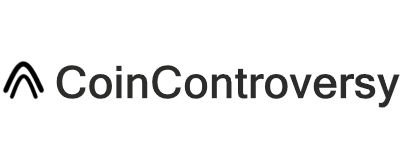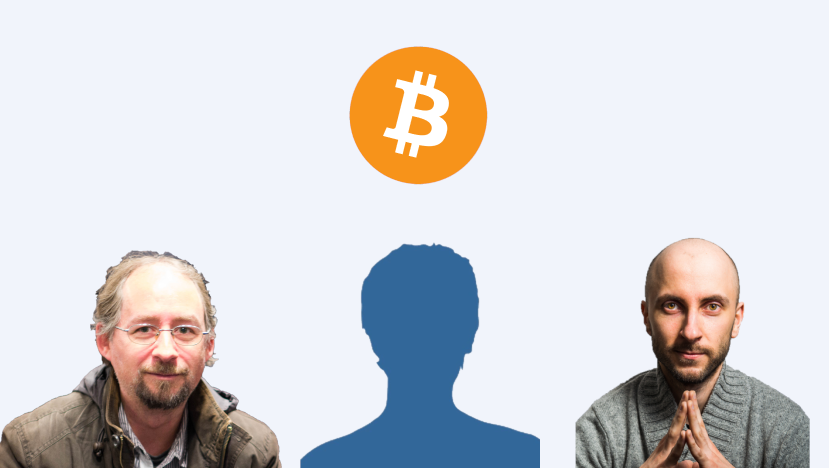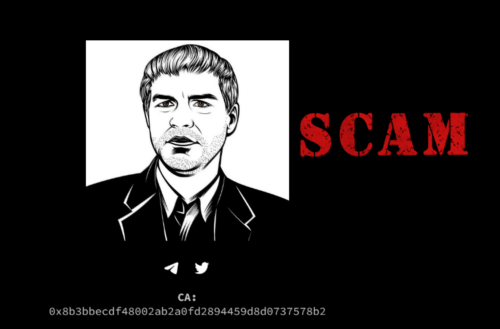Nick Szabo, The Real Satoshi Nakamoto: The Definitive Case Study
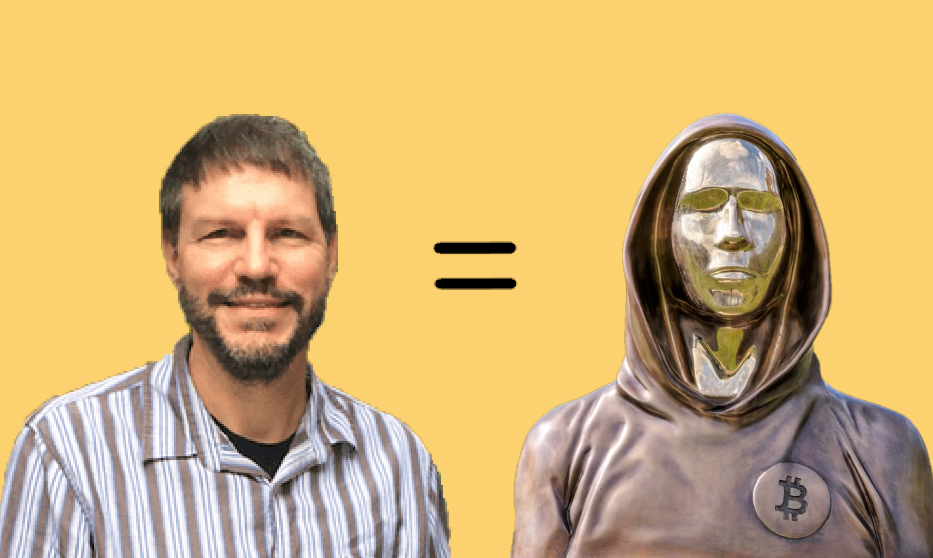
Table of Contents
- The birth of Bitcoin
- Who is Nick Szabo?
- The most ambitious cypherpunk
- Bit gold is the predecessor of Bitcoin
- Szabo asked for Bit gold contributors 6 months before the whitepaper
- Bit gold appears to be the early draft of Bitcoin
- Satoshi oddly didn't cite Bit gold in the whitepaper
- Satoshi tried to avoid Bit gold's discussion
- Uniquely identical personalities and skills
- Szabo's ideas match Satoshi's early code
- Immensely similar writing and coding styles
- Szabo's OPSEC skills are extraordinarily strong
- Satoshi had a deep respect for Hal Finney, Szabo's good friend
- "bit coin" appeared in a comment referring to Bit gold on Szabo's blog 6 months before the whitepaper
- A Satoshi Easter egg was a motivation for Szabo
- Possible hints
- Crypto leaders seem to understand who Szabo is
- Common misconceptions and mostly weak opposing arguments
- Szabo is Hungarian-American and the first Satoshi Statue is in Hungary
- Conclusion
The birth of Bitcoin
During the 2008 financial crisis, a visionary computer scientist driven by an ambition to challenge central banks, invented Bitcoin, the world's first peer-to-peer digital cash system utilizing asymmetric cryptography. Bitcoin's enigmatic creator shrouded himself in the pseudonym "Satoshi Nakamoto" to maintain anonymity.
Embracing a profound commitment to the principles of decentralization, Satoshi left the project in 2011. My extensive research on Satoshi points to renowned computer scientist Nick Szabo, the inventor of smart contracts and Bitcoin's precursor, Bit gold.
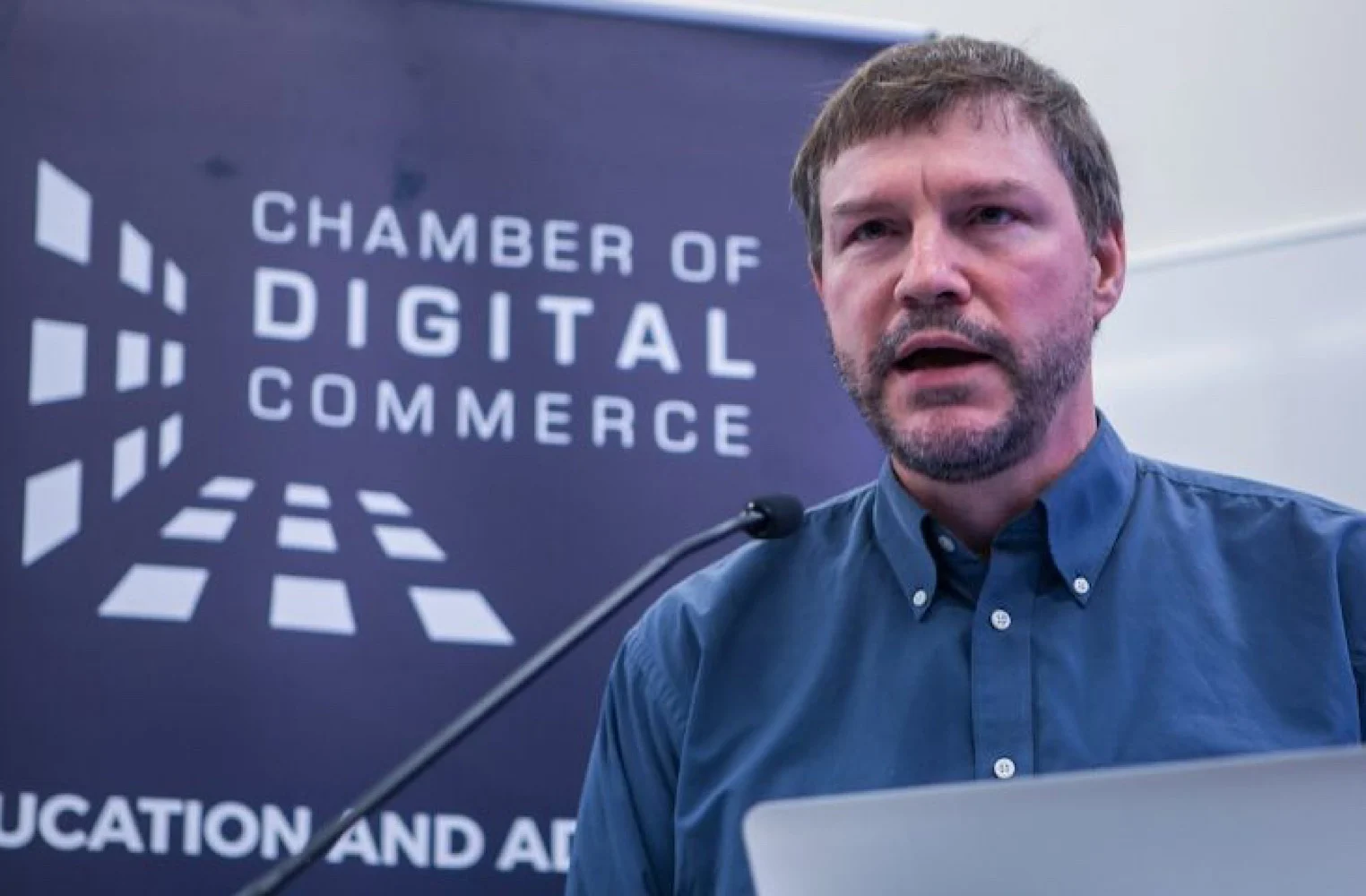
Who is Nick Szabo?
One of the most influential computer scientists of all time, Nick Szabo is an American polymath with expertise in economics, libertarianism, cryptography, programming, law, and science. Szabo's friend, Donald McIntyre, describes Szabo as a "quiet master of cryptocurrency" and says that his works are:
"comparable to Einstein, Heisenberg, Bohr, Born, and Schrödinger"
In 1989, Szabo earned a bachelor's degree in computer science at the University of Washington, later returning to California (his birthplace), becoming more involved in extropianism (futurology). Along with fellow extropians Wei Dai and Hal Finney, he joined the cypherpunk movement in the early 1990s due to the overlapping libertarian ideas with extropianism.
Cypherpunks are computer programmers who put the power of privacy and secure communication back into the hands of the public through open source software. A leading voice in the movement, Szabo played an important role in hosting real life cypherpunk gatherings alongside Hal Finney, whose early involvement helped shape Bitcoin's future direction.
Notably, Szabo worked at the NASA jet propulsion laboratory, demonstrating his strong math skills. In 2006, Szabo graduated from George Washington Law School with a Juris Doctor. For his many contributions to various academic disciplines, Szabo was awarded an honorary doctorate in the social sciences along with a professorship from Francisco Marroquín University in 2017.
The most ambitious cypherpunk
Szabo has stated on many occasions that he was inspired by David Chaum, the widely recognized inventor of digital cash, and Tim May, a cypherpunk, who in 1988, wrote the "Crypto Anarchist Manifesto," outlining the movement's goals.
In 1995, Szabo began working as a consultant for Digicash, the first digital cash attempt started by none other than David Chaum.
Szabo's groundbreaking 2001 paper, "Trusted Third Parties are Security Holes," laid out the foundational arguments behind distributed networks functioning without trusted intermediaries. This influential work continues to shape the thinking of Bitcoin advocates across the world.
Of all Satoshi candidates, Nick Szabo and Hal Finney were the only cypherpunks motivated enough to continue working on serious digital cash designs in the 2000s after Digicash's bankruptcy. Namely, they were Bit gold and its variant (more on this later).
Bit gold is the predecessor of Bitcoin
Nick Szabo invented Bit gold in 1998, a sketch for a decentralized cryptocurrency using "bit gold miners" to solve "complex mathematical puzzles." Bit gold happens to use Bitcoin's proof-of-work algorithm: Adam Back's Hashcash.
Importantly, Szabo refers to Bit gold as Bitcoin's "predecessor design."
The project was first released on a private email list that Szabo started, known as "Libtech." Compellingly, the recipients were Hal Finney, Wei Dai, Tim May, as well as economists George Selgin and Larry White.
Many don't know that Wei Dai released his B-Money proposal on this list, and went to the same university as Szabo.
Szabo has an impressive blog known as Unenumerated, where he displays his expertise. He decided to publish Bit gold in 2005 after Hal Finney encouraged him to.
In a 2005 blog post, "Antiques, Time, Gold and Bit gold," Szabo quintessentially stated:
"There are some problems involved with implementing unforgeable costliness on a computer. If such problems can be overcome, we can achieve bit gold. This would be the first online currency based on highly distributed trust and unforgeable costliness rather than trust in a single entity and traditional accounting controls. Hal Finney has implemented a variant of bit gold based on a tamper-evident computer plug-in card, for which remote users can verify what code is running on the card."
This passage shows that Szabo, as early as 2005, believed his Bit gold design was likely going to be the first secure, P2P online currency. It also demonstrates that Hal Finney's RPOW was one of Szabo's key inspirations.
Further showing his motivation, Szabo stated in a largely unknown Bit gold draft:
"Bit gold, even more so than precious metals, will become a hedge and safe haven for preserving value in the face of credit and political exposures."
Additionally, in Szabo's 2011 blog post titled, "Bitcoin What Took Ye So Long," he equates the early ideas of Bitcoin to Bit gold:
"The short answer about why [Bitcoin] took so long is that the bit gold/Bitcoin ideas were nowhere remotely close to being as obvious [as] gwern suggests."
For context, Gwern is another Satoshi researcher. The timing of Szabo's blog post is compelling. May 2011 was reportedly the same month Satoshi sent has last emails to core developers; according to Nathaniel Popper, a former New York Times journalist, who described this in an detailed 2015 article about Szabo being the likeliest Satoshi candidate:
"Mr. Szabo first made brief mention of Bitcoin on his blog in mid-2009, and in 2011, when the currency was still struggling to gain traction, he wrote about it again at greater length, noting the similarity between bit gold and Bitcoin.... May 2011 was also the last time Satoshi communicated privately with other Bitcoin contributors. In an email that month to Martti Malmi, one of the earliest participants, Satoshi wrote, “I’ve moved on to other things and probably won’t be around in the future.”
Szabo asked for Bit gold contributors 6 months before the whitepaper
In the months leading up to Bitcoin's public release, Szabo penned a blog post titled "Bit gold Markets" where he clarified aspects of the design and possible improvements. The date and URL are mismatching because Szabo later backdated the blog post for it to appear after the publication of the Bitcoin whitepaper (listed as December 27th on the new version).
Interestingly, he wrote in the comments:
"I suspect this is all obscure enough that (a) it may require most people to sit down and work it out for themselves carefully before it can be well understood, and (b) it would greatly benefit from a demonstration, an experimental market (with e.g. a trusted third party substituted for the complex security that would be needed for a real system). Anybody want to help me code one up?"
6 months later, the Bitcoin whitepaper was released. Ultimately, it is incredibly hard to to discern whether anyone actually reached out to Szabo privately.
The above revelation is outweighed by a more intriguing comment that Szabo made in the same comment section (discussed next).
Bit gold appears to be the early draft of Bitcoin
Logically, it is highly unlikely that Satoshi (or any other inventor) wouldn't have an early draft. The early draft of Bitcoin appears to be Bit gold based on Szabo's unique timing as well as the exceptionally similar names and vocabulary, distributed database, and timestamped PoW hash chain. And, of course, Szabo asserts that Bit gold is Bitcoin's predecessor.

Moreover, there is evidence to suggest that Szabo was the most dedicated cypherpunk to continue working on a digital cash design throughout the 2000s. Notably, Bit gold underwent substantial improvements, which Szabo summarized in the same month Satoshi sent his final emails.
One significant difference between the two designs is that Bit gold aimed for a high degree of privacy, whereas Bitcoin was to designed to prioritize other factors. Nevertheless, it is evident that Szabo continuously researched ways to enhance Bit gold over time.
Daniel Nagy, a cryptographer who frequently commented on Szabo's blog, proposed a digital cash design in 2007 that prioritized security and usability over high levels of privacy.
In an extraordinary August 2007 blog post, Szabo seemed to recognize that Nagy's privacy model would likely be the most successful, as opposed to the initial sketch of Bit gold featuring high levels of privacy:
"Thus, the main advantage of Nagy's scheme, which may or may not make up for its reduced privacy features, comes from the ability to use it without having to install any extra software at all -- to just, for example, cut and paste the cash from an e-mail where you received it from one person to an e-mail where you pay it to another. Your word processor can be your wallet. If this is an important use-case, then Nagian cash may succeed where Chaumian cash failed."
Szabo's description is strikingly similar to Bitcoin's privacy model.
Curiously, when a Bitcoin user asked Satoshi in 2010 about Bitcoin's production, Satoshi admitted that he started working on the project in 2007. Based on Satoshi's dialogue, it seemed like he wanted to improve upon an existing design by removing trust-based components:
"Since 2007. At some point I became convinced there was a way to do this without any trust required at all and couldn't resist to keep thinking about it. Much more of the work was designing than coding. Fortunately, so far all the issues raised have been things I previously considered and planned for."
6 months before the whitepaper, Szabo indicated the same notion expressed by Satoshi regarding trust when discussing possible Bit gold improvements:
Byrne (blog commenter): "Why do the puzzling at all, rather than issuing a fixed amount of currency inflated at a predictable rate, with unique identifiers for each unit of currency?"
Szabo: "This is an interesting idea, something like the idea that the Fed should follow a simple algorithm rather than trying to outguess markets. But the real question for beating bit gold is how do we do this without having to put full trust in third parties? If we can figure that out, we've come up with something better than bit gold. ("We" as usual on this blog being just whoever wants to explore the possibility, not "the government" :-)"
Bitcoin's inflation rate happens to be algorithmically predictable. Notably, Szabo suggested someone should implement a currency better than Bit gold, inflated at a predictable rate, which is remarkably similar to Bitcoin in description.
Subsequently, in the same comment, Szabo explains a significant security flaw associated with Bit gold:
"Byzantine security is far from perfect. In layman terms it just means that when everybody sends everybody else the same message, far more people have to be corrupted in order to fake the message than if the message is sent through one or a few people. Thus any given party is trusted only to a very small degree, but there is still that small degree of trust."
The important security issue that Szabo is referring to is Bit gold's vulnerability to Sybil attacks. It makes little sense why a meticulous security programmer like Szabo would ask for Bit gold contributors when he clearly did not think the security was strong enough.
In a sensational tie to his 2008 comment, Szabo eloquently explained in his May 2011 blog post how Satoshi improved upon this same security flaw:
"Nakamoto improved a significant security shortcoming that my design had, namely by requiring a proof-of-work to be a node in the Byzantine-resilient peer-to-peer system to lessen the threat of an untrustworthy party controlling the majority of nodes and thus corrupting a number of important security features. Yet another feature obvious in hindsight, quite non-obvious in foresight."
Notice how Szabo emphasizes it was "quite non-obvious in foresight," implying that it was a difficult problem to solve at the time.
Furthermore, many forget that Szabo invented an early version of the blockchain in 1998 (which didn't quite have blocks). In Bit gold, the title registry was Szabo's design for a decentralized database with shared ownership records using public key cryptography, based on a chain of digitally signed transactions (solved puzzles). It is the same database described in Szabo's exemplary paper, "Secure Property Titles With Owner Authority."
Szabo further described Bit gold in a comment on his "Bit gold Markets" blog post 6 months before the Bitcoin whitepaper; stressing its open source nature, like Satoshi did with Bitcoin:
"The entire value chain from puzzle to solution, and all transfers of title, are available for all bit gold and can be audited by anybody at any time."
Satoshi-like terms such as "chain of puzzles and solutions" and "miners" also appear in this blog post.
As a matter of fact, Szabo wrote in the same month Satoshi sent his last emails about how his design on secure property titles was crucial for the invention of Bitcoin:
"Only a few people had read of the bit gold ideas, which although I came up with them in 1998 (at the same time and on the same private mailing list where Dai was coming up with b-money -- it's a long story) were mostly not described in public until 2005, although various pieces of it I described earlier, for example the crucial Byzantine-replicated chain-of-signed-transactions part of it which I generalized into what I call secure property titles."
In a 2018 Bitcoin Magazine piece titled "The Genesis Files: With Bit Gold, Szabo Was Inches Away From Inventing Bitcoin," writer Aaron van Wirdum astutely summarized Bit gold:
"Indeed, it's not difficult to see Bit Gold as an early draft of Bitcoin. Apart from the shared database of ownership records based on public-key cryptography, the chain of proof-of-work hashes has an eerie resemblance to Bitcoin's blockchain. And, of course, the names Bit Gold and Bitcoin are not too far apart either."
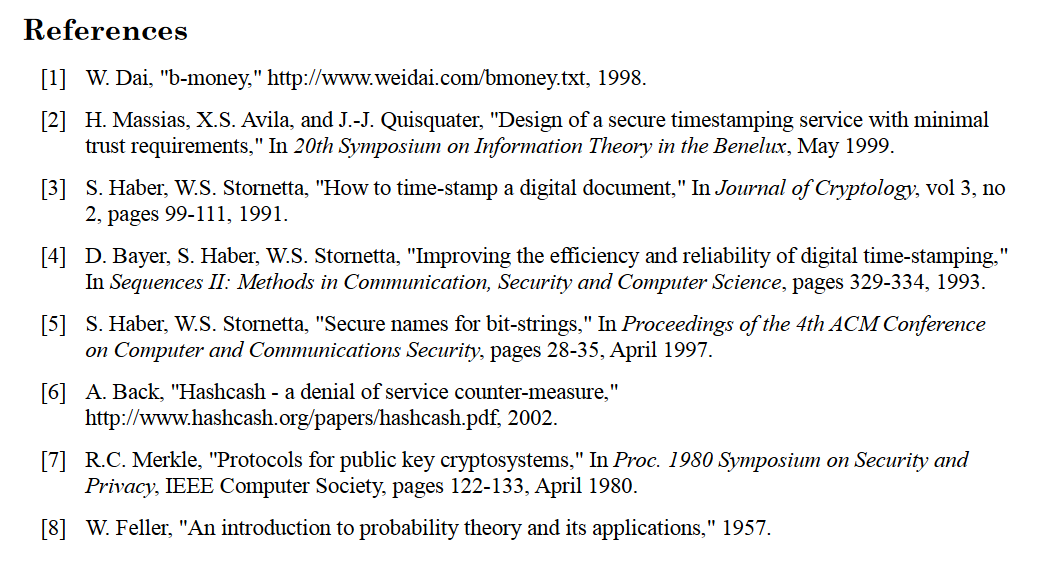
Satoshi oddly didn't cite Bit gold in the whitepaper
The Bitcoin whitepaper is a magnificent work of computer science. Whoever wrote the paper was very likely familiar with the cypherpunk movement and Bit gold. After all, Bit gold describes miners solving complex proof-of-work puzzles that are timestamped in a decentralized database.
Thus, this makes Bit gold closer to the design of Bitcoin than B-Money. As Szabo himself has summarized, the Bitcoin system is a successful implementation of Bit gold with a few key modifications such as Nakamoto consensus and a fixed supply.
Since Nick Szabo is a well-known cypherpunk and wrote Bit gold, it seems odd that Satoshi would not cite Bit gold in the whitepaper; unless Szabo was the primary author. This notion is further supported by Satoshi being careful enough to give proper credit to Adam Back and Wei Dai by emailing them to ask if the citations were correct.
Satoshi tried to avoid Bit gold's discussion
We already know Bitcoin's name is noticeably close to Bit gold, but it wasn't cited it in the whitepaper. As it turns out, Satoshi's behavior concerning Bit gold was a trend. He wanted to avoid discussion of the project until no longer possible.
When Hal Finney received the first Bitcoin transaction from Satoshi, it was clear that he took an immediate interest far beyond any other contributor. This is likely because the software had striking similarities to his friend's idea.
In a discussion with Satoshi about the network structure, one week after the whitepaper's release, Finney stated:
"Nick Szabo wrote many years ago about what he called bit gold and this could be an implementation of that concept."
In Satoshi's response to Finney, he ignored the part about Bit gold. Satoshi clearly had the opportunity to give proper credit to Nick Szabo through an email, but strangely chose not to. In 2010, however, Satoshi backtracked immensely and admitted that Bitcoin was an implementation of B-Money and Bit gold:

Interestingly, the content of both messages is identical. Hal Finney called Bitcoin an "implementation" of Bit gold, which is the same term Satoshi used in 2010. In addition, Hal Finney linked to Szabo's Bit gold sketch in 2008, so Satoshi must have seen it. Crucially, in 2010, Satoshi linked to Bit gold as well. Palpably, Satoshi felt he could no longer leave out mention of Bit gold's influence by that point.

Uniquely identical personalities and skills
Evidently, Satoshi was highly motivated to insure scarcity and a lack of central bank involvement in Bitcoin. For example, he embedded a British newspaper headline into the Genesis block stating, "Chancellor on Brink of Second Bailout for Banks."
Like Satoshi, Szabo strongly desired to stifle inflation and remove the need for central banks in Bit gold:
"The problem, in a nutshell, is that our money currently depends on trust in a third party for its value. As many inflationary and hyperinflationary episodes during the 20th century demonstrated, this is not an ideal state of affairs."
Satoshi echoes Szabo in his first forum post:
"The root problem with conventional currency is all the trust that's required to make it work. The central bank must be trusted not to debase the currency, but the history of fiat currencies is full of breaches of that trust."
Szabo published a comprehensive research study in 2002 on the history and ethnography of money titled, "Shelling Out: The Origins of Money." This is certainly the type of work Satoshi would have undertaken before Bitcoin, to fully understand how to implement peer-to-peer digital money with highly trust minimized properties.
Importantly, in Szabo's aforementioned 2011 blog post, he suggested that his paper on the origins of money should be required reading for people debating the economics of Bitcoin:
"Gold couldn't work as money until it was already shiny or useful for electronics or something else besides money, they told me. (Do insurance services also have to start out useful for something else, maybe as power plants?) This common argument coming ironically from libertarians who misinterpreted Menger's account of the origin of money as being the only way it could arise (rather than an account of how it could arise) and, in the same way misapplying Mises' regression theorem. Even though I had rebutted these arguments in my study of the origins of money, which I humbly suggest should be required reading for anybody debating the economics of Bitcoin."
Szabo fundamentally argues in his economic theory that the "unforgeable costliness" and trust minimization of certain objects, such as precious metals, make them reliable as a form of money.
For example, one cannot simply forge (fake) the grueling physical labor associated with mining real gold. In this example, it is gold's immutable properties, such as scarcity and unforgeable costliness, that enables it to be exchangeable in a trust-minimized way. The value of gold is thus not derived from characteristics such as aesthetics.
Regarding fiat money, you have to trust a central authority (a government) to issue and approve the money in order to use it, which is the opposite of gold and Bitcoin, which derive their value from the aforementioned immutable properties without relying on a central authority.
Thus, Szabo proved that sound money does not require qualities like aesthetics or being minted by a central bank to be successful. Satoshi applied Szabo's theory to Bitcoin through mining (establishing unforgeable cost by solving a proof-of-work) and its digital aspect, showing that intrinsic qualities like gold's shine are not necessary for Bitcoin to be the best money in history.
Precisely, these are the key reasons behind Szabo saying his work should be required reading for debating Bitcoin. As a matter of fact, in a little-known 2018 interview at Francisco Marroquín University, Szabo stated:
"Well, the term mining came about with the analogy to gold mining... so, my economic theory that I applied to Bit gold, and that I... or some people at least applied to Bitcoin."
Also, a financial researcher penned a well-written piece showing again how Satoshi was utilizing Szabo's unique economic arguments through his description of a non-aesthetic metal, coming to the conclusion:
"There are very few economic philosophers in the world today that can be caught giving an academically based argument for WHY Bitcoin should have value. Szabo and Satoshi each give essentially an identically unique explanation."
Furthermore, Satoshi discussed politics, despite what many people think. He is a libertarian like Szabo, stating:
"It's very attractive to the libertarian viewpoint if we can explain [Bitcoin] properly."
In addition, Satoshi had experience in smart contracts:
"The design supports a tremendous variety of possible transaction types that I designed years ago. Escrow transactions, bonded contracts, third party arbitration, multi-party signature, etc."
Nick Szabo invented smart contracts in 1996, as previously noted.
Interestingly, Daniel Nagy, the cryptographer whose digital cash design inspired Szabo in 2007, even stated that Bitcoin scripts are smart contracts in Szabo's famous 2011 blog post:
"In my opinion, [Bitcoin] has not one, but several outstanding ideas in the ways of combining well-known cryptography. Yet, I believe that it is a bubble that is going to burst due [to] some crucial deficiencies.
Strokes of genius include:
- The formal language used to describe transaction details. Smart contracts right there!
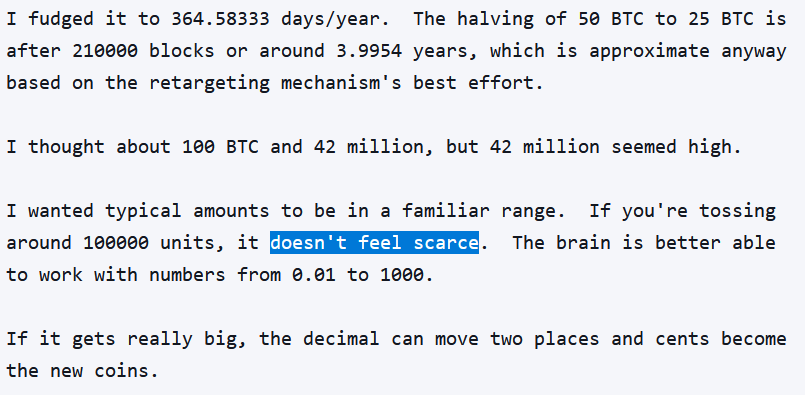
As previously stated, Satoshi was strongly motivated by the idea of scarcity when designing Bitcoin, exactly like Szabo. Satoshi explained his thought process in the above 2009 email. Noticeably, in the Bit gold draft discussed earlier, Szabo emphasized Bit gold's scarcity when responding to a comment by Hal Finney:

What's more, Satoshi appeared to support the existence of altcoins in writings such as below:
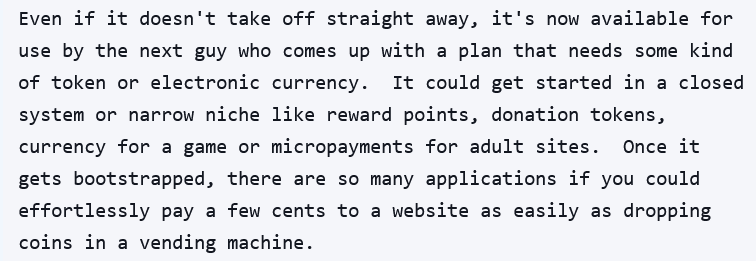
Strikingly, Szabo is one of the few Satoshi candidates who likes some altcoins in addition to Bitcoin (such as Monero). This is partially explained by the fact that Szabo invented smart contracts, which are a great deal of altcoins.
In addition, having studied the history of money in great detail, Szabo understands that many types of scarce objects existed throughout history, utilized by diverse groups of people—a scenario that he strongly supports in the digital world:
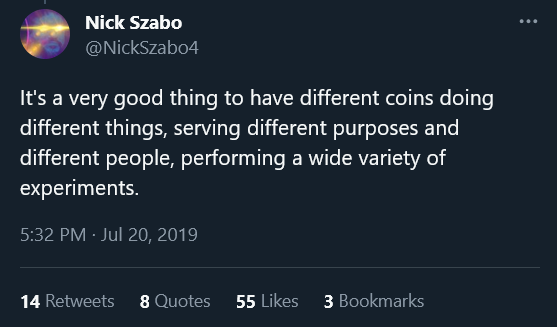
Further building on their shared interests, Szabo knows how to speak Japanese, and, of course, Satoshi chose a Japanese name for his pseudonymous identity.
Notably, two Bitcoin researchers conducted an analysis of Satoshi's newly released emails and reached the conclusion that Satoshi was one person based in the US, operating on the West Coast, who started programming Bitcoin in January 2008. Szabo happens to reside on the West Coast.
Szabo's ideas match Satoshi's early code
As part of my research, I have examined the motivations behind Satoshi's original source code before he made changes to the final version. The most notable change was a virtual poker game that Satoshi removed in the final version of the software.
I found that Szabo was interested in virtual poker. In an October 1993 Cypherpunks email, Szabo stated:
"My own vision of cypherpunk evolution runs along the following lines... online markets: Internet video poker, election outcome markets, satellite track betting, etc."
There is another noteworthy similarity between the ideas of Szabo and Satoshi in the early code that I discovered.
Curiously, Satoshi programmed an unfinished digital marketplace, which he later described in an email to core developer Mike Hearn as an "eBay style marketplace":
"I was trying to implement an eBay style marketplace built in to the client."
Strikingly, Szabo highly respected eBay's design in his research paper on the origins of money:
"It is no coincidence that markets in rare objects and unique artwork – usually sharing the attributes of collectibles described above – have enjoyed a renaissance during the last century. One of our most advanced high-tech marketplaces, eBay, is centered around these objects of primordial economic qualities."
Immensely similar writing and coding styles
Fittingly, Nick Szabo is often shown as having the most similar writing mannerisms to Satoshi. A group of 40 final year Aston University stylometry students, led by Professor Jack Grieve, stated in a 2014 study of the whitepaper:
"The number of linguistic similarities between Szabo’s writing and the Bitcoin paper is uncanny, none of the other possible authors were anywhere near as good of a match. We are pretty confident that out of the list of people regularly referred to as possibilities, Nick Szabo is the main author of the paper, though we can’t rule out the possibility that others contributed."
While there is a decent probability that Satoshi consulted others for assistance, the important part of the study was the conclusion that Szabo was the main author of the whitepaper. Furthermore, another stylometry researcher wrote a 2017 paper about Satoshi's writing style compared to leading candidates, where he came to the conclusion that Szabo was the most similar individual.
In 2016, a computer science researcher conducted an analysis of various leading candidates' code and found that Szabo displayed an intriguing similarity with Satoshi (commenting style), which the others didn't.
Later research has shown James Donald (not in the aforementioned analysis) also shares this similarity. However, while still a stronger candidate than most, Donald famously spoke to Satoshi using his public identity, while there is no known correspondence between Szabo and Satoshi.
Szabo's OPSEC skills are extraordinarily strong
When people began to speculate on the identity of Satoshi Nakamoto, Nick Szabo was the first person suspected. By examining the principles of Occam's Razor, it's easy to understand why.
Szabo's OPSEC skills are so strong that people theorized in 2011 that he didn't exist, suggesting his name was an alias for famous mathematician John Nash.
Just like Satoshi, Szabo is an experienced user of pseudonyms. In 1993, while communicating on the cypherpunk mailing list, Szabo described his frequent use of pseudonyms:
"In my limited experience creating Internet pseudonyms, I've been quite distracted by the continual need to avoid leaving pointers to my True Name lying around -- excess mail to/from my True Name, shared files, common peculiarities (eg misspellings in written text), traceable logins, etc.... The hazards are everywhere."
Furthermore, Szabo stated in a 2006 blog post:
"Another good use for pseudonyms.... to stay alive."
There is evidence leading in the direction of Satoshi faking his British writing mannerisms for the purposes of OPSEC.
Researchers determined in a study that Satoshi's language use was highly erratic, and he actually used both British and American English often, contrary to popular belief. In fact, Satoshi even used American English alongside British English in the same posts and emails at times.
Given this evidence and Satoshi's many other precautions, it appears highly likely that his semantics were another red herring.
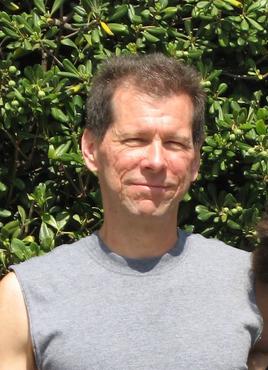
Satoshi had a deep respect for Hal Finney, Szabo's good friend
Satoshi Nakamoto sent the first Bitcoin transaction to Hal Finney. It is possible this is simply due to the fact Finney loved the idea. However, when you consider the broader picture, it is a truly odd coincidence that Finney happened to be the second user of Bitcoin when he and Szabo were working on Bit gold-related ideas for years prior.
When discussing the software with another individual on the Bitcoin forum, Finney stated:
"I'd like to hear some specific criticisms of the code. To me it looks like an impressive job, although I'd wish for more comments. Now I've mostly studied the init, main, script and a bit of net modules. This is some powerful machinery."
"That means a lot coming from you, Hal. Thanks."
This is notable because, while he still thanked other Bitcoin core developers, Satoshi did not appear to say anything along the lines of "coming from you," to anyone but Finney. The deep respect expressed by Satoshi implies he knew of Finney before the creation of Bitcoin, lining up flawlessly with Szabo's friendship with Finney.
While this quote could be attributed to the fact that Finney received the first transaction and was a valuable contributor, it doesn't explain why Satoshi didn't state the same to others. In addition, it was revealed in Satoshi's newly released emails with Martti Malmi that he knew about Finney's RPOW and its influence, saying:
"[Hal] helped me a lot defending the design on the Cryptography list, and with initial testing when it was first released. He carried this torch years ago with his Reusable Proof Of Work (RPOW)."
"bit coin" appeared in a comment referring to Bit gold on Szabo's blog 6 months before the whitepaper
A user named "Eddie" used the term "bit coin" to refer to Bit gold multiple times in a comment on Szabo's important blog post "Bit gold Markets," which was written 6 months before the Bitcoin whitepaper:
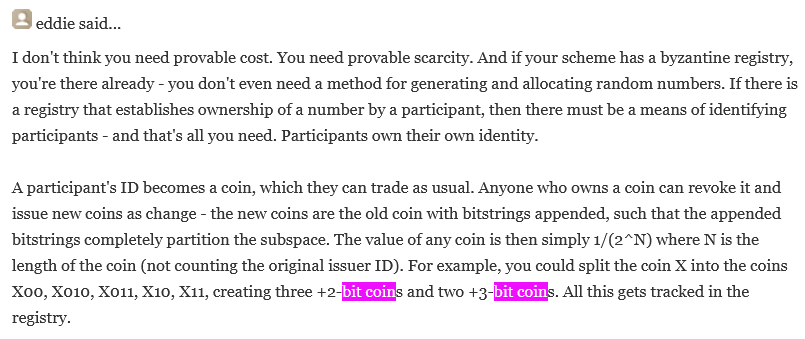
It is unclear why Eddie suddenly used that crucial term while also combining "bitgold" and using the correct spelling, "bit gold," too. A few possible answers are: they were typos, or he thought it was a better name. Crucially, since this was Szabo's blog, it means he likely saw Eddie's comment before the term "Bitcoin" even existed under Satoshi's identity.
A Satoshi Easter egg was a motivation for Szabo
Besides the fact that Bitcoin is an obvious attempt to mirror a scare commodity like gold in the digital world, mysterious references by Satoshi show that he was highly motivated by gold. Namely, Satoshi listed his birthday on the P2P Foundation forum as April 5, 1975.
April 5th, 1933 happens to be the day US President Franklin D. Roosevelt signed Executive Order 6102, which made it illegal for Americans to hoard gold. In a change of heart, the US government reversed this policy in 1975.
Remarkably, Szabo mentioned FDR's gold ban on his blog exactly 10 days before Satoshi registered the bitcoin.org domain, stating:
"Due to personal cash flow needs, I am selling some of my collection. Nobody is printing any more of this kind of money and it is a great hedge against inflation. As a collectible it is subject to less political risk than gold (recall FDR's confiscation of gold in the U.S., for example)"
Given the content and how close this blog post is to the Bitcoin.org registration date, it begs the question, what exactly was Szabo generating funds for?
In addition, Szabo has frequently referred to the same event as a motivation for his work in many speeches.
Possible hints
Nick Szabo tends to stay away from the topic of Satoshi, but occasionally, despite some denials, (which many expect Satoshi would do), he reveals things that suggest he knows far more about Bitcoin's creation than he's stated. It is important to remember that there is nothing publicly tying Szabo to the development of Bitcoin.
When former NYT journalist Nathaniel Popper (previously mentioned) approached Szabo at a dinner party to probe his involvement in the creation of Bitcoin, Szabo told Popper:
"I mean, the reason people tag me is because you can go through secure property titles and bit gold — there are so many parallels between that and Bitcoin that you can’t find anywhere else."
Szabo's comments to Popper led former Gizmodo journalist Kate Knibbs to famously state in an article:
"Even Nick Szabo thinks that Nick Szabo is probably Satoshi Nakamoto."
Further supporting Szabo's comment about the unique parallels between Bit gold and Bitcoin, is a summary by Popper of what Szabo's former coworkers at an early Bitcoin company had to say about his abilities:
"While he was still there, though, the array of arcane skills and knowledge at his command led several colleagues to conclude that Mr. Szabo was most likely involved in the creation of Bitcoin, even if he didn’t do it all himself."
On Twitter, when making a tweet about his "old cryptocurrency design called bit gold," one user asked:
"Then what is your new design?"
Szabo curiously responded with:
"Bit gold II"
Additionally, when a Twitter user asked Szabo why Bit gold failed, Szabo replied:
"It's much easier to run actual software than a design for software."
Most impressive, in Szabo's 2011 blog post explored above, he stated:
"Myself, Wei Dai, and Hal Finney were the only people I know of who liked the idea (or in Dai's case his related idea) enough to pursue it to any significant extent until Nakamoto (assuming Nakamoto is not really Finney or Dai). Only Finney (RPOW) and Nakamoto were motivated enough to actually implement such a scheme."
Szabo himself was among the only three people he listed to like the idea of a decentralized cryptocurrency like Bitcoin. Through his reference to RPOW as a variant of Bit gold, Szabo could be hinting that himself and Hal Finney were the only ones motivated enough to actually implement Bitcoin.
Crypto leaders seem to understand
The smartest individuals in the crypto space know a great deal about Nick Szabo since he invented smart contracts and Bit gold. However, it goes much further than that. Well known computer scientists in the crypto space are individuals who know a deep amount about Satoshi's skills, since many of those same skills are used to start other projects.
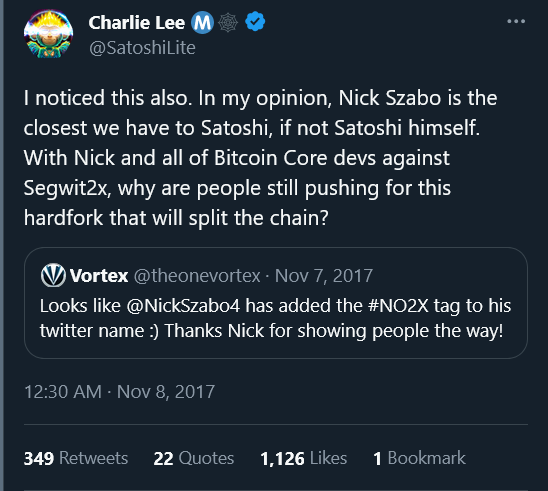
The creator of Litecoin, Charlie Lee, stated in 2017:
"In my opinion, Nick Szabo is the closest we have to Satoshi, if not Satoshi himself."
As the creator of Litecoin (a well-known Bitcoin fork), Lee is highly familiar with the technology behind Bitcoin.
In a blog post penned by Emin Gun Sirer, famously titled, "How to Spot Satoshi," the former Cornell professor and computer scientist who founded Avalanche, reached a fascinating conclusion about Satoshi:
"Interestingly, I have come across one person who was a perfect fit. That person had the precise same intellectual signature as Satoshi, someone who could have written, word for word, some of Satoshi's forum posts. Is that person Satoshi? Well, most likely, though there is a tiny probability that they are instead an intellectual doppelganger."
This led to perceptive comments by readers such as:
"I can't help but wonder if you're obliquely referencing Nick Szabo in this post."
As it turns out, they aren't the only ones.
Elon Musk, the wealthy co-founder of PayPal and Dogecoin proponent, famously stated in December 2021:
"[Nick Szabo] seems to be the one more responsible for the ideas behind Bitcoin than anyone else."
This statement by Musk is strongly supported by the fact that Szabo has published over 20 research papers on Bitcoin-related ideas, while most other candidates haven't come close.
Common misconceptions and mostly weak opposing arguments
When you look at the many internet discussions speculating on the identity of Satoshi Nakamoto, Nick Szabo is consistently found at the top.
However, the most common argument against Szabo being Satoshi is that he has denied it. Logically, though, the chances of Satoshi outright admitting to being the person are exceedingly low.
In addition, some argue it is strange that Satoshi would not cash out his Bitcoin by now, and that the only explanation is that he is dead. However, it is simply impossible to put oneself in the shoes of Satoshi.
The 1 million Bitcoin figure that many people throw around is derived from the "Patoshi" pattern: a unique, early Bitcoin mining pattern used by an unknown individual. This remarkable discovery was made by a researcher who posited that, conceivably, it could belong to Satoshi. There are several problems with this scenario, though.
We don't know for certain if "Patoshi" is really Satoshi, despite the arguably strong evidence. It could be someone else entirely, but even if it wasn't, we don't what Satoshi ended up doing with his stash of Bitcoin, assuming Patoshi is Satoshi.
Another problem is that if there were others who advised or helped "Satoshi" from the start, it's possible they divvied up some of the possible Bitcoin together.
One possibility is that he burned the private keys, which would make the coins lost forever, leading to the Bitcoin price rising more over time due to the greatly reduced supply. This course of action is often suggested as likely by many in the Bitcoin community because of a fascinating statement made by Satoshi in 2010:
"Lost coins only make everyone else's coins worth slightly more. Think of it as a donation to everyone."
Szabo's humble personality does line up with both the above quote and a Satoshi who would decide to burn the private keys for the greater good of the project.
Furthermore, the researcher who discovered the "Patoshi" pattern mentioned that the structure of the pattern suggests that Satoshi was actually doing it to help bolster the security of the network in its infancy. This also lines up with someone like Szabo, who was a security programmer by trade.
There are numerous other possible explanations for why Satoshi hasn't sold his coins. For example, Satoshi could be eyeing an even grander price target, such as $300,000, or maybe he doesn't intend to sell at all. Satoshi could have decided that he would like his Bitcoin to stay in Bitcoin and not be converted to fiat money.
This is the problem with trying to figure out why Satoshi hasn't moved his coins; it's simply impossible to decern why. You can only evaluate the likelihood of each possible course of action based on Satoshi's personality.
Regarding the ability to program Bitcoin, some say that Szabo is not experienced enough to be Satoshi. However, Szabo's open source web code says otherwise. That code is not the work of an amateur, but of a seasoned expert.
Additionally, in a 2017 Tim Ferriss podcast interview, which included tech entrepreneur Naval Ravikant, Szabo denied the notion that he was inexperienced at programming after Ravikant questioned his ability to program Bit gold:
Ravikant: "Nick, you only had the theory of Bit gold, you're not a serious enough programmer to create Bit gold."
Szabo: "Well, I am a serious programmer, but.... I.... didn't get around to programming Bit gold."
Also, you'll notice that Szabo, like other times, gave no concrete reason as to why he didn't make Bit gold a reality. In addition, Szabo's strong computer science education and status as a well known cypherpunk show that the notion that he didn't possess the abilities to program Bitcoin doesn't appear to match the evidence.
Further strengthening this point, author Dominic Frisby revealed in his famous 2014 book, Bitcoin: The Future of Money?, that Szabo said to him privately:
"C++ is a great language for implementing cryptographic primitives because of its efficiency."
Szabo's statement implies that he has coded with C++ in the past. Logically, the real Satoshi would hide his C++ code from the public due to obvious reasons. Based on his analysis, Frisby concluded that Szabo was Satoshi. Admittedly, given the lack of such evidence in a public example, it's hard to conclude. Conceivably, someone else could have written the code.

The last common argument is that Szabo stopped using double spaces in his online texts after the 90s, but this is a misconception. Szabo has never used double spaces on his blog to begin with, which many people incorrectly think is the only public work he published after the 90s. The above 2005 email shows Szabo using double spaces while discussing how RPOW is a working version of Bit gold.
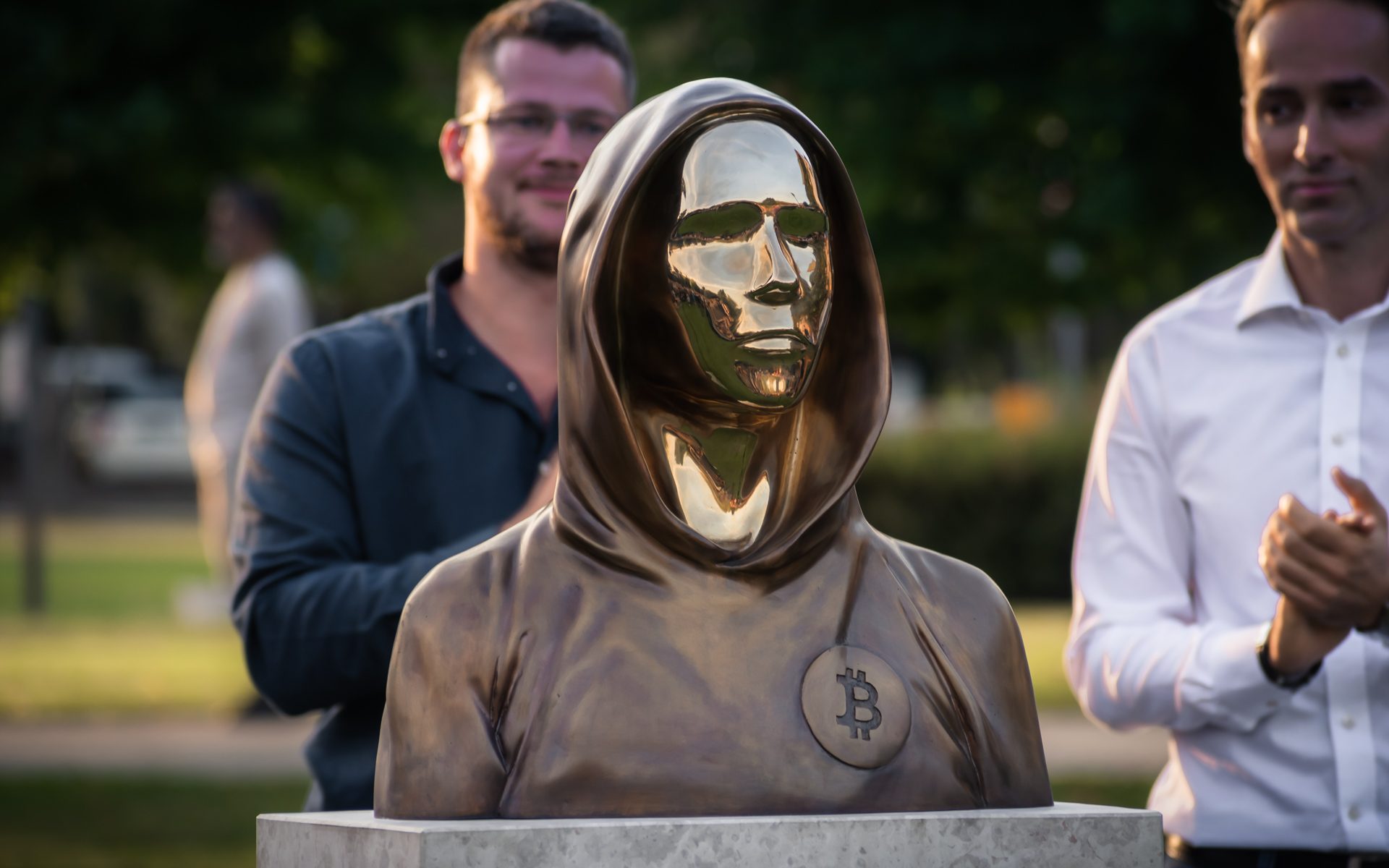
Szabo is Hungarian-American, and the first Satoshi statue is in Hungary
Of all the places on Earth for the first Satoshi Nakamoto statue to be erected, Hungary was peculiarly chosen. Szabo's father was a Hungarian who opposed the communist regime in the 1950s and immigrated to America for freedom. This has inspired Szabo throughout his life, especially for his work to create a secure financial system untethered from governments.
Conclusion
Bitcoin has revolutionized the global financial landscape, providing millions of previously unbanked individuals with access to trust minimized financial services. Satoshi Nakamoto is a visionary who did a phenomenal job hiding his identity from the world.
The evidence presented in this article demonstrates that Satoshi appears to be one person who was highly motivated. However, it can't be ruled out that contributors were involved.
When people discuss the identity of Satoshi Nakamoto, he is often referred to as a humble genius with a mastery of economics, cryptography, and computer programming. Based on the above research, Nick Szabo appears to be the only candidate to identically match the unique personality of Bitcoin's inventor.
* Disclaimer: This article is based on extensive research and the conclusions reached by the author are opinions, not established fact. Readers should evaluate independently.
* Please respect Mr Szabo
* Due to the length of this article, a small number of longer quotes have been abbreviated to concisely present key parts. The content of the quoted material has not been altered. However, some quotes may contain terms like "it," which require context. These items are replaced with their intended meaning in brackets, e.g., "[Bitcoin]."
